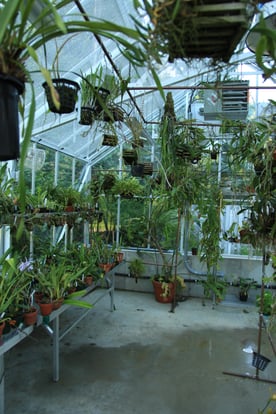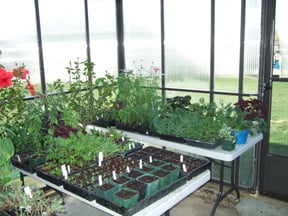Quick Answer:
To grow healthy plants in greenhouse pots, select the right pot size and material—using breathable options like terra cotta or fabric pots for moisture-sensitive plants—choose nutrient-rich soil suited to your crop, and refresh or repot plants seasonally to prevent root crowding and nutrient depletion, ensuring optimal growth and flexibility.
How do you grow?
Essentially there are two ways to grow in soil in your greenhouse. You can grow in pots or you can grow in planting beds. We look now at growing in posts, and we will consider the positives and negatives growing directly in the ground.
 If you are growing annuals in pots inside your greenhouse and the plants are failing, maybe it's time to dump out the pots and the plants and start growing a fresh new crop? What do you need to know to grow the best plants ever in pots? You need to decide on the best pot size, the best type of pot and the best soil.
If you are growing annuals in pots inside your greenhouse and the plants are failing, maybe it's time to dump out the pots and the plants and start growing a fresh new crop? What do you need to know to grow the best plants ever in pots? You need to decide on the best pot size, the best type of pot and the best soil.
Pot Size
Pots lined up on a bench, wire shelf or on the ground allow ultimate flexibility in a home greenhouse. You can grow a quick crop, dump the soil and grow the same crop in the same spot right away. Or you can grow a more permanent crop like lemons on top of landscape fabric or greenhouse gravel ground cover. Depending on the crop, pots will vary in size.
Annual flowers are often started in cell packs and moved up to a 9 cm or 4" pot. Larger geraniums or tomatoes, need a larger pot as they grow. The 4" plants are typically moved up to a standard one-gallon or 15 cm pot as they become rootbound. Eventually, tomatoes are moved into a 10-15 gallon pot for the duration of the season.
If you grow bigger more permanent plants like lemons or ginger you will need bogger pots. Start small and slowly move permanent plants into bigger pots with drainage holes.
Pot Types
Black plastic nursery pots work for most plants, including tomatoes, unless the plants are from a dry climate. Lemons, for instance, grow in dry Mediterranean areas with excellent drainage. By the time they are moved out of their tiny pots, they need something more breathable. Pots made of Terra cotta, or unglazed pottery, stay cool because they breathe. As moisture is wicked from the pot it evaporates and cools the air in the soil.
Fabric pots, made from recycled plastic water bottles, will wick moisture away from the soil and the added bonus is that permanent roots never circle the pot like they do in plastic. I like to move one-gallon lemons into a five-gallon root pouch. If you only have plastic pots move up only one size at a time - from 1-gallon to a 2-gallon, so the roots dry completely between each watering.
For quick crops like tomatoes, the options are many but for plants that like to dry out be more selective. To be extra careful you can wash your fabric or plastic pots between use. After washing in soapy water, spray plastic pots with a diluted hydrogen peroxide solution or add bleach to the machine when you wash fabric pots.
Best Soil
Annual flowers or vegetables are fast-growing and if they are moved outside in the summer they are usually good to go with a pre-mixed potting soil such as Sungro or Promix.
If you select a soil with fertilizer added, you may not need to add extra fertilizer at all if seedlings frown this way are planted in outdoor soil in spring. If plants are lagging, start fertilizing with a liquid organic or dry fertilizer once the seedling has true leaves and not before.
After one season pots become dense with roots. Once the soil is depleted and full of roots action is required. If you want that plant to stay small simply tip the plant out of the pot., remove a bit of the outer soil, cutting off part of the roots with a knife. Then, add fresh soil to the pot and replant in the same pot. If the plant is a perennial or woody and you want it to grow big then move it to a bigger pot when it wilts or needs watering more than once a day.
Annual plants in pots with spent soil are dumped into the compost pile at the end of the season.
Plants that will stay in their pots for a full season or more, like tomatoes and lemons, grow better in a triple mix soil. This mix consists of 1/3 soil, 1/3 compost and 1/3 commercial potting mix. Gardeners use triple mix in plant pots both in the greenhouse and outdoors to grow flowers, vegetables, and herbs in pots.
More from Donna
For more great tips from Donna, visit www.donnabalzer.com.
You can also read Donna’s gardening books: No Guff Vegetable Gardening with Steven Biggs and her just released Gardener’s Gratitude Journal: Part Diary, Part Personal Growing Guide.



